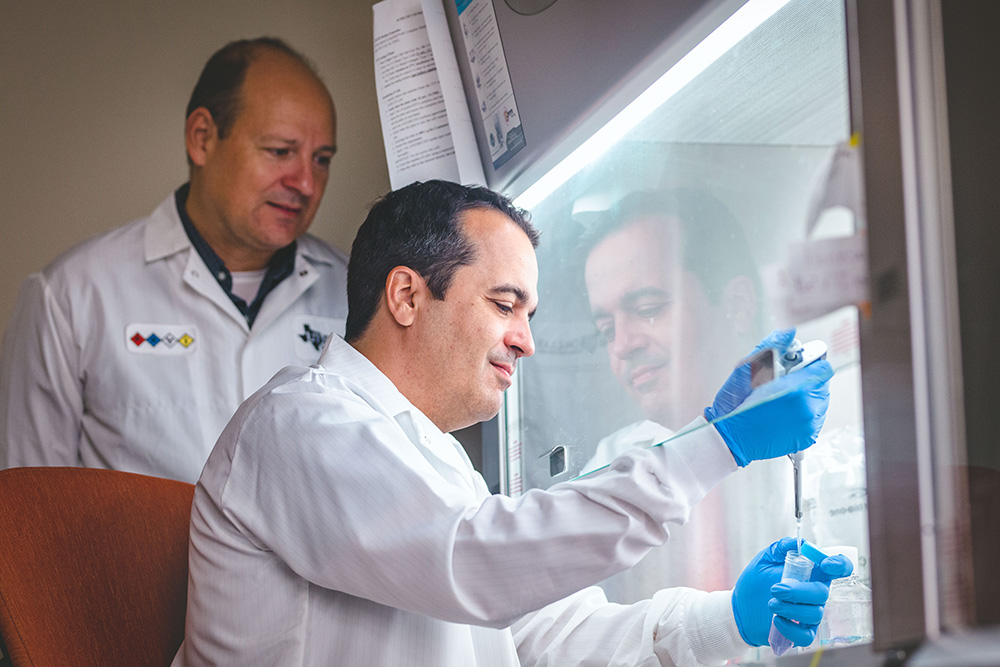New Technology Protects Authenticity of Engineered Cell Lines
By: Kim Horner | June 3, 2022

Advances in synthetic biology and genome editing have led to a growing industry to develop customized cell lines for medical research. These engineered cell lines, however, can be vulnerable to misidentification, cross-contamination and illegal replication.
A team of University of Texas at Dallas researchers has developed a first-of-its-kind method to create a unique identifier for each copy of a cell line to allow users to verify its authenticity and protect the manufacturer’s intellectual property (IP). The engineers demonstrated the method in a study published online May 4 and in the May 6 print edition of Science Advances.
The patent-pending technology is the result of an interdisciplinary collaboration between UT Dallas faculty members. The study’s co-corresponding authors are Dr. Leonidas Bleris, a professor of bioengineering who specializes in genetic engineering, and Dr. Yiorgos Makris, a professor of electrical and computer engineering who is an expert on electronics hardware security.

Custom cell lines are used in the development of vaccines and targeted therapies for a range of diseases. The global cell-culture market is projected to reach $41.3 billion by 2026, an increase from $22.8 billion in 2021, according to a forecast by market research company MarketsandMarkets.
The UT Dallas engineers’ research to develop unique identifiers for genetically engineered cells was inspired by what are called physically unclonable functions (PUFs) in the electronics industry. A PUF is a physical characteristic that can serve as a unique “fingerprint” for a semiconductor device such as a microprocessor. In semiconductors, PUFs are based on natural variations that occur during the manufacturing process and must meet three requirements: They must have a unique fingerprint, produce the same fingerprint each time they are measured and be virtually impossible to replicate.
To apply that concept to engineered cells, the researchers developed a two-step process that takes advantage of a cell’s ability to repair damaged DNA, which is made up of sequences of small molecules called nucleotides.
“Companies developing cell lines are making a huge investment. We need a way to differentiate between 1,000 copies of the same product. Even though the products are identical, each of them has a unique identifier, which cannot be replicated.”
Dr. Leonidas Bleris, the Cecil H. and Ida Green Professor in Systems Biology Science in the Erik Jonsson School of Engineering and Computer Science
First, they embedded a five-nucleotide barcode library into a part of the cell’s genome called a safe harbor, where the modification will not harm the cell. The barcodes alone, however, do not satisfy the three properties of PUFs. In the second step, researchers used the gene-editing tool CRISPR to cut the DNA in the proximity of the barcode. That action forces the cell to repair its DNA using random nucleotides, a process called nonhomologous error repair. During this repair process, the cell naturally inserts new nucleotides into the DNA and/or deletes others — collectively, these are called indels (insertions/deletions). These random fixes, in combination with the barcodes, create a unique pattern of nucleotides that can help distinguish the cell line from any other.
“The combination of barcoding with the inherently stochastic cellular error repair process results in a unique and irreproducible fingerprint,” said Bleris, who is also the Cecil H. and Ida Green Professor in Systems Biology Science.
This first generation of CRISPR-engineered PUFs provides the means for researchers to confirm that the cells were produced by a given company or lab, a process called provenance attestation. With further research, the engineers aim to develop a method for tracking the age of a specific copy of a cell line.

To learn more about how UT Dallas is enhancing lives through transformative research, explore New Dimensions: The Campaign for UT Dallas.
“Companies developing cell lines are making a huge investment,” Bleris said. “We need a way to differentiate between 1,000 copies of the same product. Even though the products are identical, each of them has a unique identifier, which cannot be replicated.”
Makris said that the business of developing engineered cells is so new that companies are focused on monetizing their investments rather than on security and provenance attestation. He said the semiconductor industry was the same way at first until counterfeiting and tampering incidents highlighted the need for security measures.
“We think that this time maybe we can be ahead of the curve and have that capability developed by the time the industry realizes they need it,” Makris said. “It will be too late when they realize they got hacked and someone monetized their IP.”
Other authors of the study include Dr. Yi Li, bioengineering research scientist; Mohammad Mahdi Bidmeshki PhD’18, a former postdoctoral researcher in Makris’ lab; Taek Kang, a biomedical engineering doctoral student and Eugene McDermott Graduate Fellow; and Chance M. Nowak, a bioengineering graduate student.
The research was funded by the National Science Foundation, the Seed Program for Interdisciplinary Research in the UT Dallas Office of Research and Innovation, and the TxACE Collaboration Initiative, which supports collaborations of researchers in the University’s Texas Analog Center of Excellence (TxACE) with non-TxACE faculty members.
Media Contact: Kim Horner, UT Dallas, 972-883-4463, kim.horner@utdallas.edu, or the Office of Media Relations, UT Dallas, (972) 883-2155, newscenter@utdallas.edu.





